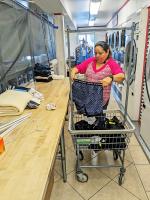CINCINNATI — For the self-service laundry that also offers wash-dry-fold (WDF) service through drop-off and/or pickup and delivery, when attendants process orders at the same time self-service customers are trying to do their laundry, there’s always the risk of creating conflict, especially if both groups are vying for the same washers and dryers.
Dedicating an area (or, as you’ll read, time periods) to WDF processing will help keep a laundry’s self-service customers happy and the separate revenue streams flowing freely. Of course, laundromats can vary in service needs, store size and design, so what one business can accomplish easily may not come so simply for another.
American Coin-Op interviewed the owners of three different laundry businesses, in three different parts of the country, to see how they have approached the concept of dedicated WDF space.
A HYBRID METHOD
Queen City Laundry has four stores on the east side of Cincinnati that offer self-service laundry, drop-off laundry and dry cleaning, and pickup and delivery laundry. Dave and Carla Menz are the owners.
“We do have a dedicated space for WDF but we don’t have dedicated equipment,” Dave Menz says. “I would describe us as kind of a hybrid, so we don’t have the stereotypical OPL equipment. We use our equipment in the store, but other than washing and drying, we have a completely separate area during the daytime hours, when our store is open to the public, where we actually … fold and package our laundry.”
Queen City’s workforce includes a general manager, two assistant GMs, four store managers, two third-shift supervisors for drop-off and pickup and delivery, plus attendants and drivers. All together, the staff numbers around 40.
Menz’s WDF operation started small 10 years ago and it didn’t take him long to realize that interfering with his self-service customer base would be a mistake.
“Almost immediately, we set up what we call a drop-off room. It’s just an employee room. Some would refer to it as an office, but in some of our facilities, it’s several hundred square feet. In one, it’s several thousand square feet.”
Other than its 9,000-square-foot superstore, each Queen City Laundry has a roughly 20-by-12 room where walk-in drop-off orders are processed and drop-off drycleaning orders are stored.
“We wash it in the washers, we dry it in the dryers,” Menz says. “We pull it out immediately and either lay it flat over carts and roll them in the back room or we (physically) take them in the back room and actually fold them and package them right there.”
The superstore does utilize that basic process but also employs a second-shift crew comprised of three people that processes only WDF orders. All pickup and delivery orders are routed to the facility.
“They’re only allowed to use about one-third of our store for wash and dry,” Menz says. “We immediately pull it back into that separate processing facility. Back there, they have all the racks and folding tables. They have tons of room to work, shelving, everything they could possibly need to complete the order.”
A third-shift crew of seven to nine people (varies depending on volume) processes the remaining WDF work once the store is closed to the public.
Queen City Laundry trains attendants and processors extensively on how to process WDF orders without interfering with self-service customers. They’re taught to use only washers at the rear of the store, for example, or the bottom pockets of stack dryers, because self-service customers tend not to use them.
“There’s definitely an art to it, for sure,” Menz says. “And it’s not really as complex as it sounds. I mean, it’s a lot of, like, common sense. If your primary focus is ‘I want to do everything I can to avoid building a separate facility and paying rent,’ it’s … how can we do this without getting in our customers’ way.”
Check back Thursday for Part 2
Have a question or comment? E-mail our editor Bruce Beggs at [email protected].





















